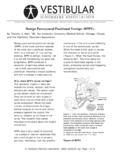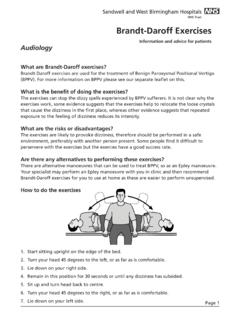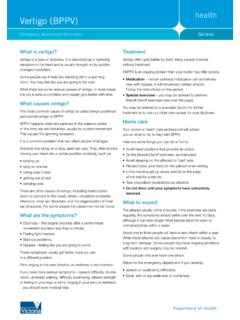Transcription of Horizontal canal benign paroxysmal positional …
1 487dOi: canal benign paroxysmal positional vertigo : diagnosis and treatment of 37 patientsVertigem posicional parox stica benigna do canal Horizontal : diagn stico e tratamento de 37 pacientesEliana Teixeira Maranh o1, 2, P ricles Maranh o-Filho3 benign paroxysmal positional vertigo (BPPV) is the most frequent type of vertigo1,2,3 with prevalence between and per 100,000 population, and lifetime prevalence esti-mated of in females, in males, and overall1. BPPV generally has the highest age distribution in the sixth decade of life3,4, with a prevalence approaching 9% among the elderly population5. It is characterized by brief, recurrent episodes of vertigo triggered by changes in head position. Its pathophysiology, so called the vestibular stones, concept, is either due to abnormal stimulation of the dome caused by free-floating otoliths within semicircular canals (canaloli-thiasis), or otoliths clinging in the dome (cupulolithiasis)4,6,7.
2 The duration, frequency and intensity of symptoms, as well as the nystagmus phenotype, vary depending on the canal in question and the location of the debris within them. The idio-pathic form is the most frequent and the average duration of episodic symptoms is about two weeks8. The right ear is usu-ally more involved9. Eighty-six percent of affected individuals seek medical care but only 8% receive effective treatment8. When considering the frequency of affected semicircular ca-nals, certainly for anatomical / positional reasons, BPPV of the Horizontal canal (HC-BPPV) is four times less frequent than the posterior canal (PC-BPPV)6,10, but this frequency is increasing and currently, depending on the study, the recogni-tion of HC-BPPV ranges from 10% to ,12. Although the symptoms in HC-BPPV and PC-BPPV are similar, important 1 Instituto Nacional de C ncer, Departamento de Fisioterapia, Rio de Janeiro RJ, Brazil. 2 American Physical Therapy Association for Vestibular Rehabilitation, Alexandria VA, USA;3 Universidade Federal do Rio de Janeiro, Hospital Clementino Fraga Filho, Departamento de Neurologia, Rio de Janeiro RJ, Brazil.
3 Correspondence: Eliana Teixeira Maranh o; Avenida das Am ricas, 1155 / 1705; 22631-000 Rio de Janeiro RJ, Brasil; E-mail: of interest: There is no conflict of interest to 09 September 2014; Received in final form 10 January 2015; Accepted 30 January paroxysmal positional vertigo (BPPV), the most frequent cause of vertigo is associated with high morbidity in the elderly population. The most common form is linked to debris in the posterior semicircular canal . However, there has been an increasing number of reported BPPV cases involving the Horizontal canals. The purpose of this article is to highlight the clinical features, diagnosis , and treatment in 37 patients with Horizontal canal BPPV; twenty-six with geotropic nystagmus, and eleven with the apogeotropic form. Treatment consisted of the Gufoni manoeuver in eighteen patients ( ), the barbecue 360 maneuver in twelve patients ( ), both manoeuvers in four patients ( ), both manoeuvers plus head shaking in one patient ( ), and the Gufoni maneuver plus head shaking in two patients.
4 Cupulolithiasis patients were asked to sleep in a forced prolonged position. We obtained a complete resolution of vertigo and nystagmus in 30 patients ( ) on the initial : benign paroxysmal positional vertigo , Horizontal canal , dizziness, nystagmus, canalith-repositioning posicional parox stica benigna (VPPB) a causa mais frequente de vertigem e promove alta morbidade na popula o idosa. A forma mais comum est relacionada com otoconias no canal semicircular posterior. Entretanto, nos ltimos anos identifica-se cada vez mais casos de VPPB dos canais horizontais. Os principais objetivos deste artigo s o destacar as caracter sticas cl nicas, diagn stico e tratamentos aplicados em 37 pacientes com VPPB do canal Horizontal ; vinte e seis com nistagmo geotr pico, e onze com nistagmo apogeotr pico. O tratamento consistiu na manobra de Gufoni em dezoito pacientes (48,6%) manobra do churrasco 360 em doze pacientes (32,4%) ambas as manobras em quatro pacientes (10,8%) ambas as manobras mais a manobra de sacudir a cabe a (MSC) em um paciente (2,7%), e manobra de Gufoni mais MSC em dois pacientes (2,7%).
5 Pacientes com cupulolit ase dormiram uma noite na posi o for ada prolongada. Em 30 pacientes (81,0%) o sucesso terap utico ocorreu na primeira : vertigem posicional parox stica, canal Horizontal , tonteira, nistagmo, manobras de reposi o Neuropsiquiatr 2015;73(6):487-492differences in the evaluation and management exist3,13. The HC-BPPV has sudden onset and usually more intense symp-toms than the posterior canal variant, persisting longer than 30 seconds, and is often associated with nausea and even-tually vomiting. Nevertheless, its prognosis is usually better than PC-BPPV. When untreated most HC-BPPV resolve with-in 16 19 days and PC-BPPV within 39 47 days of their on-set4. The correct diagnosis type of HC-BPPV, and treatment with appropriate maneuvers allow simple and rapid healing. Our primary objective was to achieve therapeutic success, absence of vertigo and nystagmus upon application of the supine roll test on follow-up examination, within the least amount of time and using the most practical and effective maneuvers, regardless the disease June 2011 and November 2014, one hundred and ninety-three office patients with vertigo and dizziness complain were seen by the authors: 162 by ETM, and 31 by PM-F.
6 Thirty-seven ( ) aged years old (range 33 94), with positional vertigo and Horizontal position-al nystagmus were diagnosed as HC-BPPV. The time inter-val from the first vertigo crisis to an initial evaluation varied from one day to 40 years (mean SD months; median: months). Twenty-eight ( ) patients were women and nine men (women-to-men ratio: 14 ). All pre-sented the five items that make up the criteria for the clinical diagnosis of HC-BPPV3,9: 1) very short latency ( few seconds) of positional vertigo episodes; 2) purely Horizontal nystagmus towards the lower ear (geotropic) or upper ear (apogeotro-pic) induced by rotating the head while supine, with greater intensity on one side; 3) absence of spontaneous nystagmus during upright sitting position; 4) unfatigable nystagmus with repeated positioning; and 5) absence of CNS disease that can justify positional vertigo and nystagmus. All patients under-went a routine clinical neuro-otological examination includ-ing: Otoscopy, extrinsic and intrinsic ocular motility, a search for spontaneous and gaze-evoked nystagmus, Horizontal and vertical smooth pursuit, saccades, head impulse test, limb ataxia, and static and dynamic balance, that was consistent-ly normal or negative.
7 None of them had a history of migraine or a history and examination that indicate Meni re disease, vestibular neuritis or vestibular schwannoma. Patients were submitted to the provocative Pagnini-McClure test (supine roll test)14, with a monocular video-Frenzel goggle system (Micromedical Infrared Googles RealEyes xDVR C). The roll test was done with the patient in the supine position with the head flexed 30 and rotated 90 in one direction, then returned to the starting position (head to zero degree), and the maneuver was repeated towards the opposite side. The treatment consisted in applying: Gufoni manoeuver 15,16 in eighteen patients ( ), the barbecue 360 manoeuver (BBQ)17, in twelve patients ( ), both maneuvers in four patients ( ); both maneuvers plus head shaking maneu-ver (HSM)18 in one ( ); and HSM plus Gufoni maneuver in three patients. There were no specific criteria in the choice of maneuvers used in the treatment with the exception that in some patients, the Gufoni maneuver was chosen due to over-weight or complaints of neck the Gufoni maneuver to the HC-BPPV canalolithia-sis19, the patient was quickly brought down on the healthy side from the sitting position with their legs hanging over the side, and after 2 minutes the head was turned about 45 downward, so that the nose was on the bed.
8 After 2 minutes in this position, the patient was returned to the upright posi-tion (Figure 1). The Gufoni maneuver for HC-BPPV cupulo-lithiasis, the patient head is quickly turned upward, toward the ceiling, after first being brought to the side-lying posi-tion on the affected side (Figure 2). For the BBQ the supine patient underwent a stepwise 90 turns starting with the af-fected ear-down, followed by quick rotations to complete 360 . Each position was maintained for 30 to 60 seconds until the induced nystagmus dissipated. Finally, the patient was brought to a sitting position (Figure 3). For the HSM in the yaw plane18, the examiner vigorously moved the patient s head (fitted with infrared Frenzel goggles), from side to side (30 to 45 ) for 20 cycles with a frequency of 2-3 Hz for ap-proximately 15 seconds, then stopping abruptly. It is worth mentioning that there was no concern on our part in com-paring the effectiveness between different therapeutic meth-ods.
9 Most patients were followed by telephone call, some by office visit, up from one week to two years. All images were used in accordance with legally authorized the 37 patients with HC-BPPV, twenty-six ( ) showed canalolithiasis (equally distributed on either side). Eleven patients ( ) presented cupulolithiasis; seven ( ) on the right and four ( ) on the left HSM was used in two patients with HC-BPPV cupu-lolithiasis who were resistant to treatment. In addition, we consistently requested our ten patients with cupulolithiasis to perform the forced prolonged position20 (sleep in lateral decubitus with the affected ear facing upwards for 12 hours) on the same evening of their patients ( ) were asymptomatic after just one maneuver: four after the Gufoni maneuver, and an equal num-ber after the BBQ 360 maneuver. Seventeen patients ( ) were asymptomatic after two maneuvers in the first visit day: eleven patients after the Gufoni and six patients after the BBQ 360.
10 In four patients ( ), both maneuvers were performed, and in three cases with HC-BPPV cupulolithiasis, addition-al head shaking was done. Three patients ( ) transformed HC-BPPV cupulolithiasis to canalolithiasis: after head shaking 489 Eliana Teixeira Maranh o et al. Horizontal canal paroxismal positional vertigoin the yaw plane and after the BBQ 360 maneuver17. Another patient had right posterior canalolithiasis BPPV that was trans-formed to right HC-canalolithiasis by the BBQ 360 maneuver. Seven patients ( ) had to return after an interval of two or three days to reapply the maneuvers; two returned four to the clarity of direction and intensity of nystag-mus observed with Frenzel glasses, in none of our patients required the use of the Bow and Lean test21 in order to decide the affected BPPV was mostly idiopathic but in two patients the vertigo crises began after cranial trauma. Seventeen patients ( ) had had lengthy unsuccessful treatments with anti-ver-tigo medications drugs before maneuvers were patients, despite many years of disease duration and several vertigo episodes, were asymptomatic after complet-ing treatment with the maneuvers as determined by the ab-sence of vertigo and nystagmus in the supine roll test.















